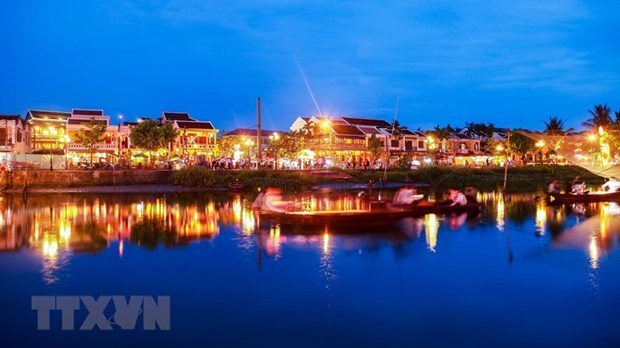Quang Nam promotes “One destination – Two heritage” brand
Houses with ancient tiled roofs, mossy walls with bougainvillea racemes and shimmering lanterns of Hoi An ancient town and the tranquility of My Son Sanctuary have a special appeal to both domestic and foreign tourists, when coming to the central province of Quang Nam - which is known as “One Destination-Two Heritage”.
 My Son world cultural heritage complex (Photo: VNA)
My Son world cultural heritage complex (Photo: VNA)Quang Nam (VNA) - Houses with ancient tiled roofs, mossy walls with bougainvillea racemes and shimmering lanterns of Hoi An ancient town and the tranquility of My Son Sanctuary have a special appeal to both domestic and foreign tourists, when coming to the central province of Quang Nam - which is known as “One Destination-Two Heritage”.
My Son world cultural heritage
My Son relic site, located in Duy Phu commune of Duy Xuyen district, is the most famous architectural complex of Cham people in Vietnam. The site was built from the late fourth century to the 13th century.
On April 29, 1979, the Ministry of Culture and Information recognized it as an artistic architectural relic site.
In 1898, M.C Paris, a French national, discovered the My Son complex of temples hidden in a narrow valley among dense tropical forests. Not long after that, scientists and archaeologists from the French Institute for Eastern Archaeology came to the site to study epitaphs, architecture and sculptures in My Son. It was them who found out that My Son was the most grandiose religious vestige of the Cham ethnic in Vietnam, which was continuously built throughout a course of more than 1,000 years.
The construction of temples at the site was started in the 4th century under the reign of King Bhadravaman (from 349 to 361), and lasted until early 14th century under the reign of King Jaya Simhavanman III ( Che Man).
The complex used to house more than 70 temples and towers with various styles of architecture and sculptures typically representing each historical stage of the Champa Kingdom. Most of the architectural and sculptural works in My Son were under the influence of Hinduism. Most temples were designed to face the East, the direction of the sun rise, as Cham people believed that the East was the place where the gods lived. While, exceptionally, a few towers faced the west or both east and west, representing the idea of commemorating the afterworld where the kings were deified as gods after death, and ancestors.
Due to natural disasters and war-related damages, as of 1975, only 32 temples and towers remained standing with some 20 still intact in My Son. Regrettably, Tower A1, the biggest tower with a height of 24m and six small towers surrounded, was damaged by US bombing in late 1969.
Through ups and downs, My Son remains a relic site with unique cultural and architectural values.
The site was officially recognized as World Cultural Heritage by UNESCO on December 1, 1999.
Hoi An ancient town
 A corner of Hoi An ancient town at night (Photo: VNA)
A corner of Hoi An ancient town at night (Photo: VNA)Hoi An ancient town was recognized as a national cultural and historical relic site on March 19, 1985.
This is the only remaining urban residential architectural relic of the Middle Ages in Vietnam. From the 16th century to the 19th century, Hoi An used to be a hub of international trade on the East-West trade route, and the most prosperous trading port in the southern part of Vietnam during the Nguyen dynasties, as trading ships from Japan, China, Portugal, Spain and the Netherlands often came to Hoi An to exchange and trade goods.
According to statistics, Hoi An is home to 1,360 relics and scenic spots, including 1,068 ancient houses, 19 pagodas, 43 shrines, 11 ancient wells, one ancient bride and 44 tombs.
The unique ancient bridge, known as Cau Pagoda (also known as Lai Vien Kieu), was built by Japanese migrants in the 17th century. The bridge is 18.7 metres long and 3 metres wide.
Hoi An has more than 10 communal houses, most of which are dedicated to people who founded villages. The oldest communal houses are Xuan My communal house (built in the nineteenth century) and Cam Pho communal house (1818).
Currently, Hoi An is the only place in the world that still preserves a harmonious multi-ethnic cultural heritage with townhouses, temples and pagodas.
Hoi An was officially recognized by the UNESCO World Heritage Committee as World Cultural Heritage during its 23rd session held from November 29 to December 5, 1999.
Developing tourism from heritage sites
The Quang Nam heritage tour “One Destination – Two Heritage” has become a top choice for many domestic and foreign tourists when coming to central Vietnam.
Since receiving UNESCO recognition, Quang Nam has invested in upgrading roads and service areas. Since then, the province has seen a surge in the number of tourists.
2019 was a successful year for the province’s tourism sector as it was honoured with important international awards. Hoi An topped the list of the 13 most beautiful towns throughout Asia compiled by CNN travel. It was also named as the best city in the world by the American travel site www.travelandleisure.com./.












